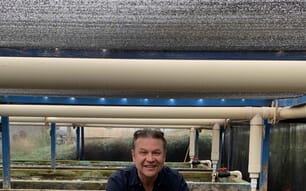This venture in aquaculture development comes at a crucial time for East Timor, as the country seeks to diversify its economy and feed its growing population while protecting its coastal and marine resources for tourism and future generations. Mud crabs are a prized delicacy throughout Asia, commanding high prices in upper-end restaurants and hotels.
The facility is the country's first brackish water hatchery. It was built by ACDI/VOCA's Mud Crab and Fish Cultivation programme in coordination with the East Timor Ministry of Agriculture and Fisheries, and with funding from the United States Department of Agriculture's (USDA) Food for Progress programme.
The nation's stable weather patterns and over 700 km of coastline are well-suited for sustainable coastal aquaculture production. Still, fish-farming practices that have grown rapidly during the last 20 years in other Asian nations such as Viet Nam, the Philippines and Indonesia are almost nonexistent in East Timor.
New Hatchery Brings New Economic Opportunities
Mud crabs were selected because they can be environmentally sustainable to cultivate, have strong market potential in nearby countries such as Japan, Taiwan and Singapore, and can be fattened in coastal ponds alongside milkfish or tilapia.
Once operational, the hatchery is expected to produce 240,000 mud crabs per year. The facility can also be modified to produce brackish and saltwater fish.
The new complex incorporates a number of technologies that are firsts for East Timor: four ponds totaling two hectares; a powerful 4-cylinder generator; a UV seawater filtration system; numerous tanks for spawning and cultivating crabs; and a state-of-the-art laboratory designed for ensuring quality control, growing phytoplankton and rearing the youngest crab larvae.
Seed stock produced at the hatchery will be transported to cooperatives whose members have already been trained to fatten mud crabs in cages and pens placed in coastal mangrove areas. The program began organizing cooperative groups in 2011, and now estimates that 70 cooperatives will benefit from the hatchery's production.
Hatchery is Environmentally Friendly and Sustainable
"Hatchery seed stock is easier and more environmentally friendly to raise than wild catch," said Jinki Comon, the programme's technical manager. "Sourcing crabs from the hatchery rather than coastal areas lessens overfishing."
The potential for the facility does not end with mud crabs—it could easily be modified to produce other aquatic species such as snapper, milkfish or grouper and sea bass.
This potential is not lost to Dani Fernandes , who will manage the hatchery as it is turned over to the ministry in the coming months. "I hope that [the hatchery] will become a center for aquaculture and for research that will attract and train the type of people that can help develop Timor Leste's fisheries," said Fernandes.




